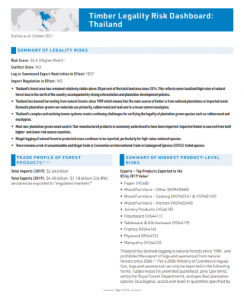Thailand Timber Legality Risk Dashboard
By Forest Trends View PublicationThailand’s forest area has remained relatively stable above 30 percent of the total land area since 2014. This reflects some localized high rates of natural forest loss in the north of the country accompanied by strong reforestation and plantation development policies. Thailand has banned harvesting from natural forests since 1989 which means that the main source of timber is from national plantations or imported wood. Domestic plantation-grown raw materials are primarily, rubberwood and teak and to a lesser extent eucalyptus. Thailand’s complex and evolving tenure systems create continuing challenges for verifying the legality of plantation grown species such as rubberwood and eucalyptus. Most non-plantation grown wood used in Thai-manufactured products is commonly understood to have been imported. Imported timber is sourced from both higher- and lower-risk source countries.
Illegal logging of natural forest in protected areas continues to be reported, particularly for high-value redwood species. There remains a risk of unsustainable and illegal trade in Convention on International Trade in Endangered Species (CITES)-listed species.

